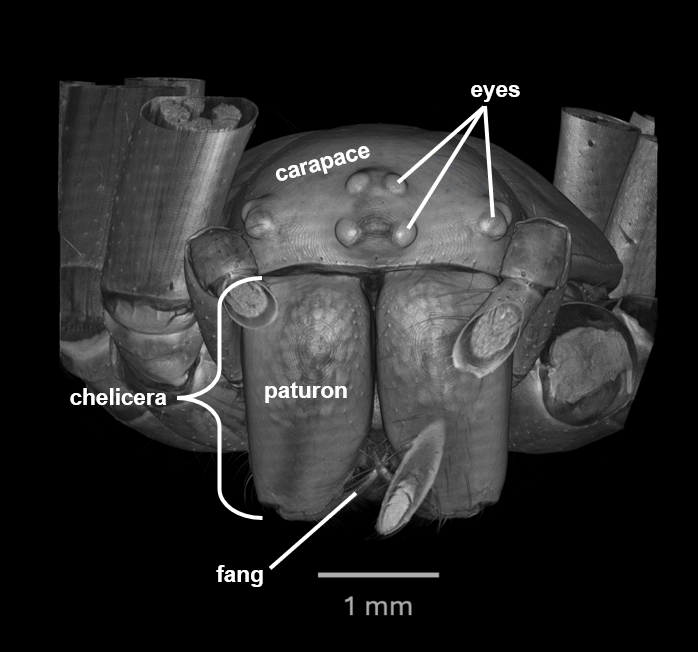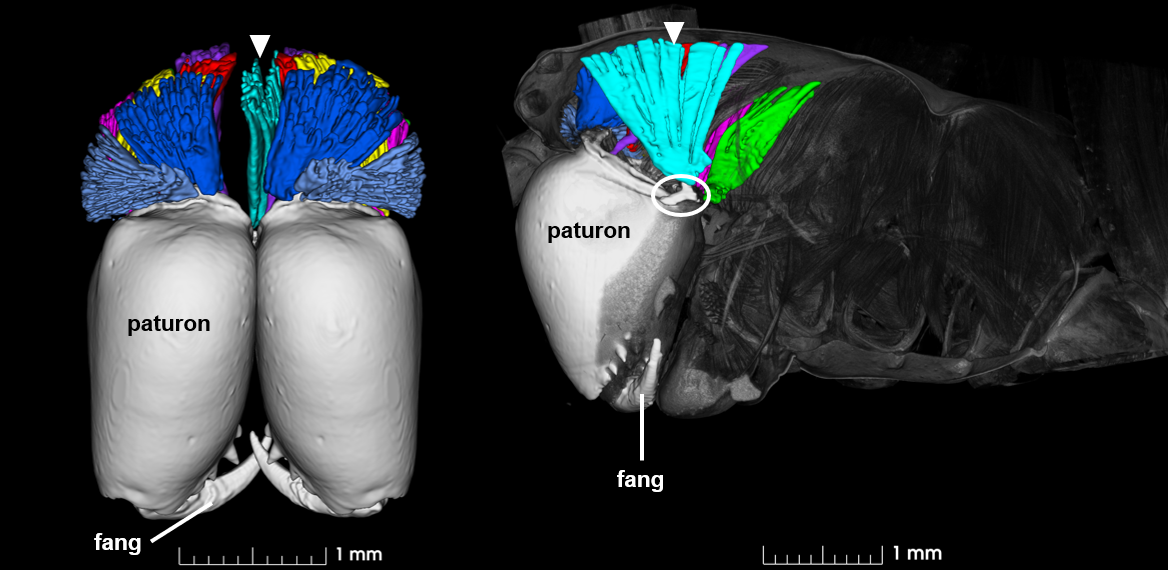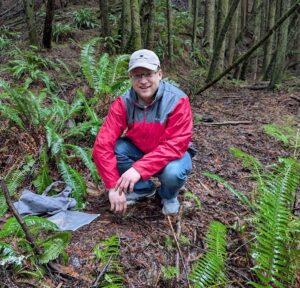Spider webs are famous for their intricacy and beauty (or perhaps they’re terrifying if you have arachnophobia). However, web-weaving has major consequences on spider jaws and how they process their prey. Spiders are a remarkable example of animals with an extended adaptation, meaning they build complex structures that influence their ecology and evolution. The towering mounds of termites and the dams and lodges of beavers are other famous examples of extended adaptations. Dr. Corinthia Black, an NSF Postdoctoral Fellow in Dr. Hannah Wood’s lab at the Smithsonian Institution, is investigating how the external adaptation of web-building has affected the physical traits of spiders. While spider webs are a uniquely innovative way to capture prey, Black’s research has found that spiders that weave webs have weaker jaw muscles that produce a lower bite force than spiders that hunt without webs. Now, Black, Wood, and the rest of their team aim to figure out why this is the case and what it means for spiders, their evolutionary history, and their lifestyles as invertebrate predators.
While all of the more than 50,000 known spider species can produce silk, many species do not use silk to build prey-capturing webs and instead live as free hunters. These free hunters use a variety of strategies to capture their prey, from jumping or running across water to using trapdoors, lures, and other cunning tactics to set an ambush. With so much diversity, it is difficult to identify the key adaptations that have had the most influence on spider evolution. However, all spiders must use their jaws in some capacity to subdue or process their prey. Since the entire spider family tree has this in common, Black and Wood identified jaw muscles and their mechanics as the perfect place to start their search for the secrets of spider evolution.
Spider jaws are very different from the jaws of most other animals. In fact, spiders technically don’t have true jaws at all. As Black shared, “we’ve got bones and muscles on the inside, spiders have ‘bones’ on the outside. We have to flip the way we think about how things function when we think about invertebrates.” Spiders have a pair of external mouthparts known as chelicerae that each contain a main segment called a ‘paturon’ tipped with a fang. Behind this pair of foreboding appendages is a central plate-like structure known as the intercheliceral (IC) sclerite along with up to nine pairs of muscles that direct the movement of these bizarre mouthparts. One of these muscle pairs is unique in its central placement and insertion on the IC sclerite, seemingly in the perfect position to coordinate cheliceral movement. As these structures are found in all branches of the spider family tree, Wood and Black chose to focus their investigation on the IC muscle.

To do this, the team integrated a variety of techniques in a robust study that included 55 species representing almost 40% of the 134 spider families. They used microcomputed tomography (µCT scanning) to obtain highly-detailed images of spider mouthparts that allowed them to visualize the IC sclerite and muscles in three dimensions. Their scans allowed them to visualize the fibers that make up the IC muscle, and by calculating the physiological cross-sectional area (PCSA) of that muscle, the team could estimate the biting force of each species. The PCSA of a muscle is measured perpendicular to the individual fibers rather than straight across the entire muscle as a singular unit, providing a more accurate estimate for the contractile force of that muscle. Finally, they performed a suite of phylogenetic analyses to identify evolutionary patterns in IC muscle function and bite force.

Black’s results revealed a striking pattern: web-building spiders have a weaker bite force than free hunters. Spider webs get their prey-capturing power from the sticky silk that spiders produce to weave them. With this in mind, the team concluded that web-building spiders have evolved weaker bite forces because their sticky webs do most of the hard work to immobilize prey, relieving their jaws of this laborious task. When the job of restraining prey can be done by a web, having robust jaws and a powerful bite becomes redundant.
However, no biological pattern is complete without exceptions. The team noted three species of web-building spiders that retain a relatively strong bite force. Among these, Stegodyphus and Thelechoris build webs with a type of silk that may be less sticky than other types of spider silk. Since their webs may play only a small role in prey restraint, these spiders may still require powerful bite forces to finish the job. While Novanapis does produce sticky silk, little is known about how it captures prey, so further studies are needed to reveal why this web-builder has such a mighty bite.
Black’s work reveals the profound effects that extended adaptations can have on the physical characteristics of animals. Broadly speaking, spider lineages that evolved to use webs for prey capture have experienced a corresponding decline in bite force. Still, there are many more questions to answer before we fully understand how spider bites work. Black noted that there are eight other pairs of muscles in spider jaws to investigate, not to mention those formidable fangs. Fortunately, Black described getting to see the insides of spiders all day as the best part of the job. With that in mind, we can look forward to more fascinating spider stories from the Wood Lab in the future!
Dr. Corinthia Black noted that this work was very collaborative and was supported by an NSF grant to Hannah Wood and Jeffrey Shultz (NSF grant DEB/IOS: 2114561). Follow the links to learn more about these scientists and their contributions to arachnology, entomology, and more! Also, see Black et al. (2024) and Wood & Parkinson (2019) for more about the muscles and machinery of spider mouthparts.
Author Bio:

Michael Kardos is a Ph.D. candidate in the Woodley Lab of Duquesne University. He is broadly interested in the evolutionary history of life on Earth and how animals have acquired their variety of body forms and life histories. His dissertation research focuses on the source and function of fluorescent skin glands in lungless salamanders. When he’s not in the lab, he enjoys being outside and watching movies.

